2006 DODGE RAM SRT-10 service
[x] Cancel search: servicePage 3724 of 5267

5.CHECK THE (K312) TTVA POSITION SENSOR SIGNAL CIRCUIT FOR A SHORT TO ANOTHERCIRCUIT
Measure the resistance between the (K312) TTVA Position Sensor Sig-
nal circuit and all other circuits in the ECM C1 and C2 harness connec-
tors.
Is the resistance below 100 kohms between the (K312) TTVA
Position Sensor Signal circuit and any other circuit(s) in the
ECM C1 or C2 harness connectors.
Ye s>>
Repair the (K312) TTVA Position Sensor Signal circuit for a
short to another circuit(s).
Perform RE TRANSMISSION VERIFICATION TEST VER -
1 (DIESEL). (Refer to 21 - TRANSMISSION/TRANSAXLE/
AUTOMATIC - 48RE - STANDARD PROCEDURE)
No>>
Go To 6
6.CHECK THE ECM OPERATION
Turn the ignition off to the lock position.
Reconnect all previously disconnected connectors.
Ignition on, engine not running.
With the scan tool, record and erase Engine DTCs.
Turn the ignition off to the lock position.
Disconnect the TTVA harness connector.
Ignition on, engine not running.
With the scan tool, read Engine DTCs.
Did the DTC Transmission Throttle Valve Position Sensor Circuit High set?
Ye s>>
Using the schematics as a guide, check the Engine Control Module (ECM) pins, terminals, and connec-
tors for corrosion, damage, or terminal push out. Pay particular attentiontoallpowerandgroundcir-
cuits. If no problems are found, replace and program the ECM per the ServiceInformation. (Refer to 8
- ELECTRICAL/ELECTRONIC CONTROL MODULES/ENGINE CONTROL MODULE - REMOVAL)
Perform RE TRANSMISSION VERIFICATION TEST VER - 1 (DIESEL). (Refer to 21 - TRANSMISSION/
TRANSAXLE/AUTOMATIC - 48RE - STANDARD PROCEDURE)
No>>
Go To 7
Page 3725 of 5267
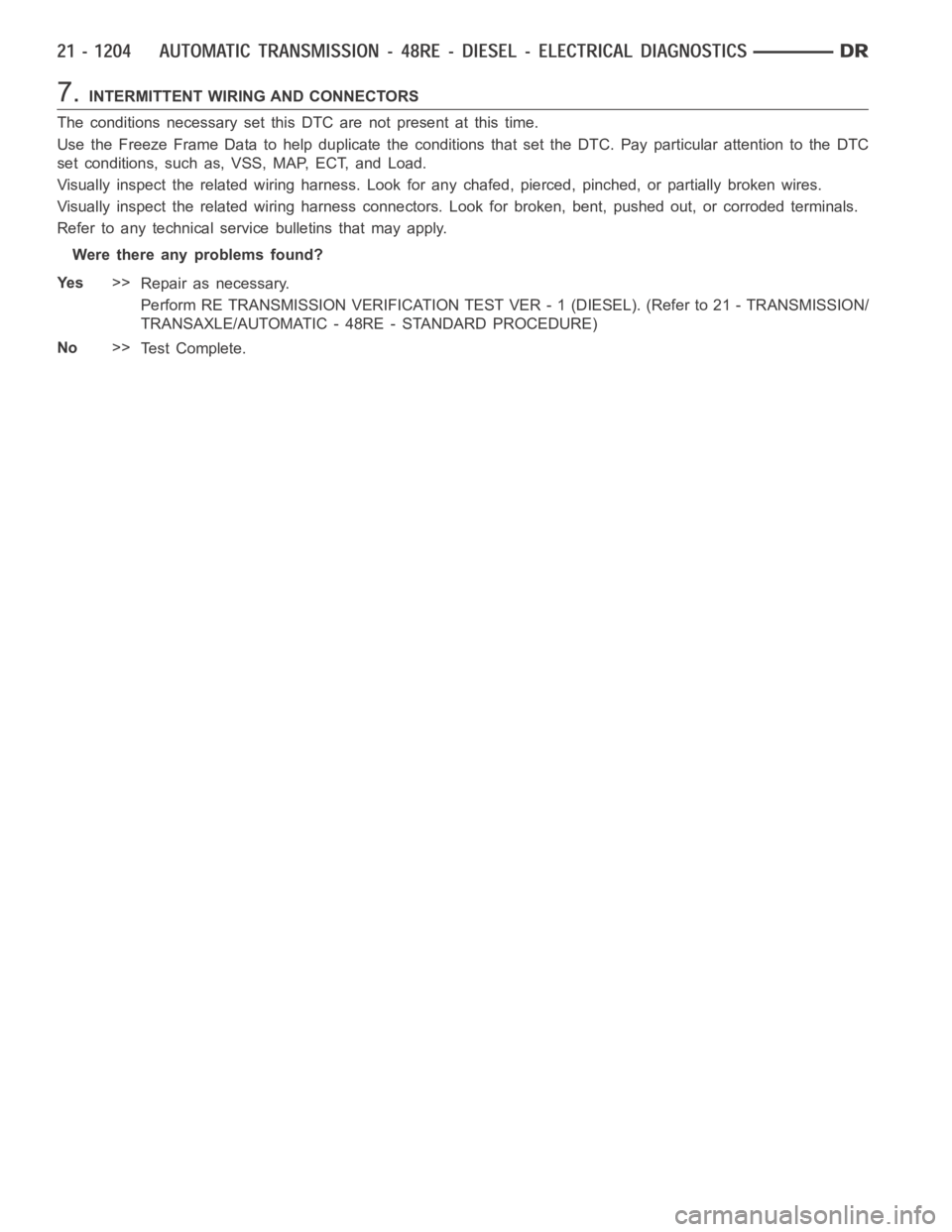
7.INTERMITTENT WIRING AND CONNECTORS
The conditions necessary set this DTC are not present at this time.
Use the Freeze Frame Data to help duplicate the conditions that set the DTC.Pay particular attention to the DTC
set conditions, such as, VSS, MAP, ECT, and Load.
Visually inspect the related wiring harness. Look for any chafed, pierced, pinched, or partially broken wires.
Visually inspect the related wiring harness connectors. Look for broken,bent, pushed out, or corroded terminals.
Refer to any technical service bulletins that may apply.
Were there any problems found?
Ye s>>
Repair as necessary.
Perform RE TRANSMISSION VERIFICATION TEST VER - 1 (DIESEL). (Refer to 21 - TRANSMISSION/
TRANSAXLE/AUTOMATIC - 48RE - STANDARD PROCEDURE)
No>>
Te s t C o m p l e t e .
Page 3728 of 5267
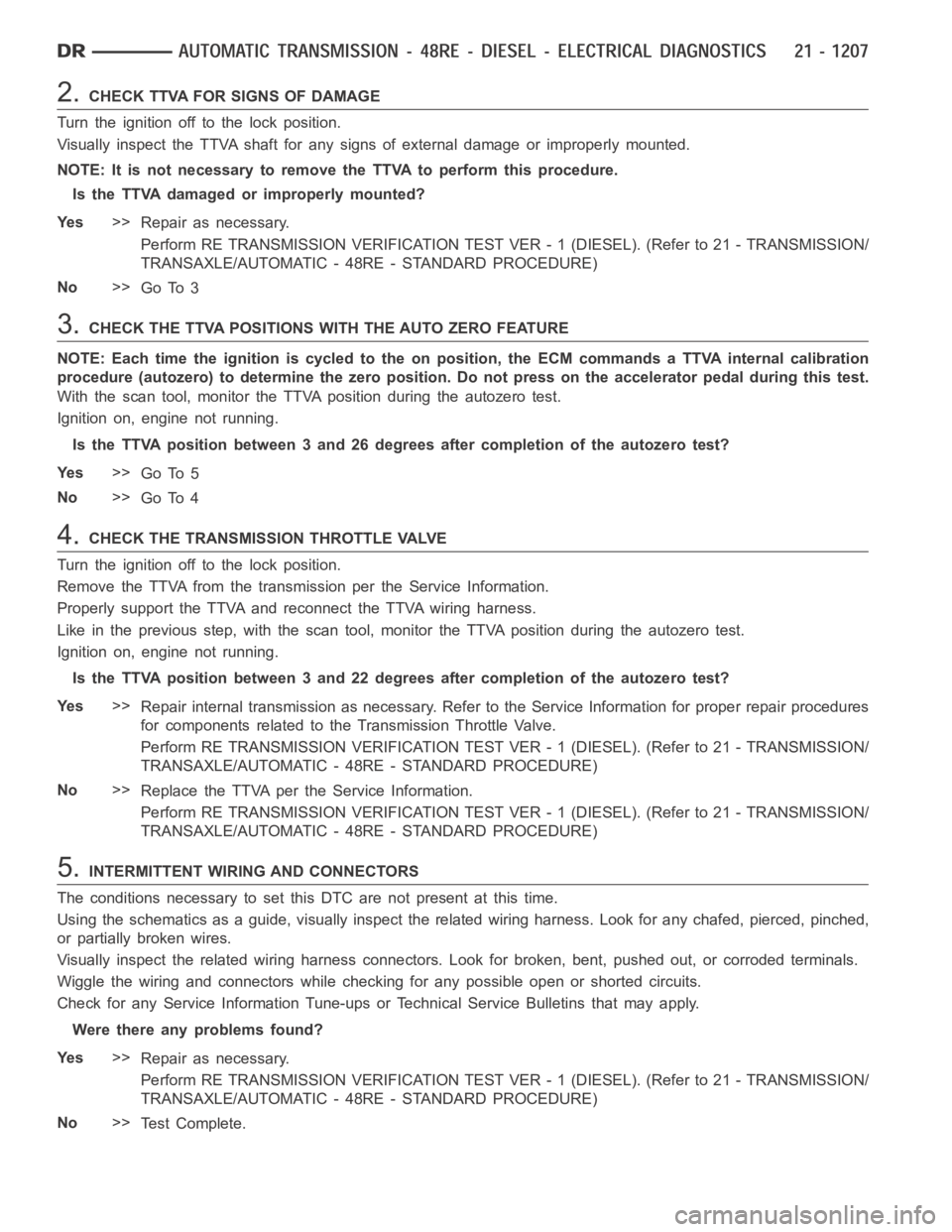
2.CHECK TTVA FOR SIGNS OF DAMAGE
Turn the ignition off to the lock position.
Visually inspect the TTVA shaft for any signs of external damage or improperly mounted.
NOTE: It is not necessary to remove the TTVA to perform this procedure.
Is the TTVA damaged or improperly mounted?
Ye s>>
Repair as necessary.
Perform RE TRANSMISSION VERIFICATION TEST VER - 1 (DIESEL). (Refer to 21 - TRANSMISSION/
TRANSAXLE/AUTOMATIC - 48RE - STANDARD PROCEDURE)
No>>
Go To 3
3.CHECK THE TTVA POSITIONS WITH THE AUTO ZERO FEATURE
NOTE: Each time the ignition is cycled to the on position, the ECM commands aTTVA internal calibration
procedure (autozero) to determine the zero position. Do not press on the accelerator pedal during this test.
With the scan tool, monitor the TTVA position during the autozero test.
Ignition on, engine not running.
Is the TTVA position between 3 and 26 degrees after completion of the autozero test?
Ye s>>
Go To 5
No>>
Go To 4
4.CHECK THE TRANSMISSION THROTTLE VALVE
Turn the ignition off to the lock position.
Remove the TTVA from the transmission per the Service Information.
Properly support the TTVA and reconnect the TTVA wiring harness.
Like in the previous step, with the scan tool, monitor the TTVA position during the autozero test.
Ignition on, engine not running.
Is the TTVA position between 3 and 22 degrees after completion of the autozero test?
Ye s>>
Repair internal transmission as necessary. Refer to the Service Information for proper repair procedures
for components related to the Transmission Throttle Valve.
Perform RE TRANSMISSION VERIFICATION TEST VER - 1 (DIESEL). (Refer to 21 - TRANSMISSION/
TRANSAXLE/AUTOMATIC - 48RE - STANDARD PROCEDURE)
No>>
Replace the TTVA per the Service Information.
Perform RE TRANSMISSION VERIFICATION TEST VER - 1 (DIESEL). (Refer to 21 - TRANSMISSION/
TRANSAXLE/AUTOMATIC - 48RE - STANDARD PROCEDURE)
5.INTERMITTENT WIRING AND CONNECTORS
The conditions necessary to set this DTC are not present at this time.
Using the schematics as a guide, visually inspect the related wiring harness. Look for any chafed, pierced, pinched,
or partially broken wires.
Visually inspect the related wiring harness connectors. Look for broken,bent, pushed out, or corroded terminals.
Wiggle the wiring and connectors while checking for any possible open or shorted circuits.
Check for any Service Information Tune-ups or Technical Service Bulletins that may apply.
Were there any problems found?
Ye s>>
Repair as necessary.
Perform RE TRANSMISSION VERIFICATION TEST VER - 1 (DIESEL). (Refer to 21 - TRANSMISSION/
TRANSAXLE/AUTOMATIC - 48RE - STANDARD PROCEDURE)
No>>
Te s t C o m p l e t e .
Page 3731 of 5267
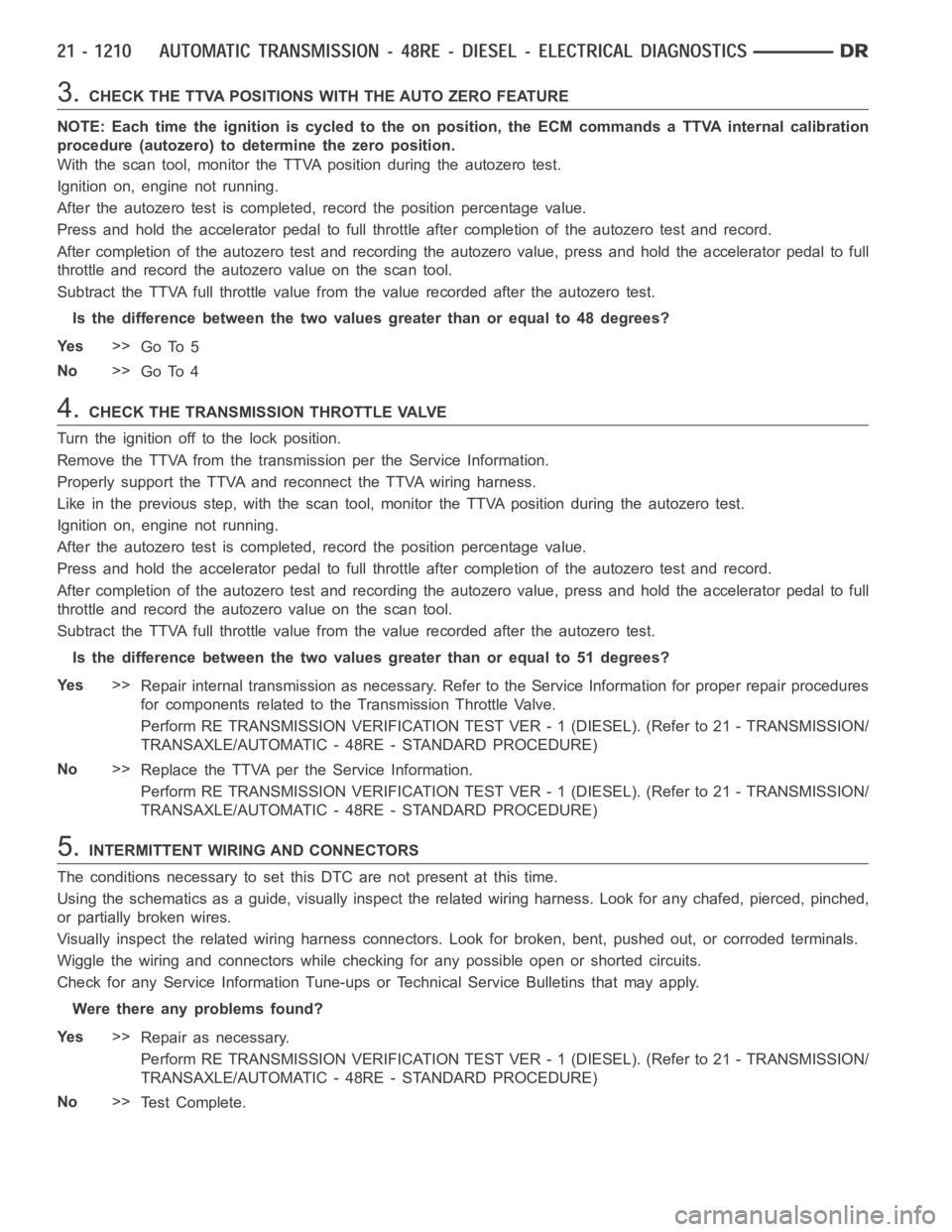
3.CHECK THE TTVA POSITIONS WITH THE AUTO ZERO FEATURE
NOTE: Each time the ignition is cycled to the on position, the ECM commands aTTVA internal calibration
procedure (autozero) to determine the zero position.
With the scan tool, monitor the TTVA position during the autozero test.
Ignition on, engine not running.
After the autozero test is completed, record the position percentage value.
Press and hold the accelerator pedal to full throttle after completion of the autozero test and record.
After completion of the autozero test and recording the autozero value, press and hold the accelerator pedal to full
throttle and record the autozero value on the scan tool.
Subtract the TTVA full throttle value from the value recorded after the autozero test.
Is the difference between the two values greater than or equal to 48 degrees?
Ye s>>
Go To 5
No>>
Go To 4
4.CHECK THE TRANSMISSION THROTTLE VALVE
Turn the ignition off to the lock position.
Remove the TTVA from the transmission per the Service Information.
Properly support the TTVA and reconnect the TTVA wiring harness.
Like in the previous step, with the scan tool, monitor the TTVA position during the autozero test.
Ignition on, engine not running.
After the autozero test is completed, record the position percentage value.
Press and hold the accelerator pedal to full throttle after completion of the autozero test and record.
After completion of the autozero test and recording the autozero value, press and hold the accelerator pedal to full
throttle and record the autozero value on the scan tool.
Subtract the TTVA full throttle value from the value recorded after the autozero test.
Is the difference between the two values greater than or equal to 51 degrees?
Ye s>>
Repair internal transmission as necessary. Refer to the Service Information for proper repair procedures
for components related to the Transmission Throttle Valve.
Perform RE TRANSMISSION VERIFICATION TEST VER - 1 (DIESEL). (Refer to 21 - TRANSMISSION/
TRANSAXLE/AUTOMATIC - 48RE - STANDARD PROCEDURE)
No>>
Replace the TTVA per the Service Information.
Perform RE TRANSMISSION VERIFICATION TEST VER - 1 (DIESEL). (Refer to 21 - TRANSMISSION/
TRANSAXLE/AUTOMATIC - 48RE - STANDARD PROCEDURE)
5.INTERMITTENT WIRING AND CONNECTORS
The conditions necessary to set this DTC are not present at this time.
Using the schematics as a guide, visually inspect the related wiring harness. Look for any chafed, pierced, pinched,
or partially broken wires.
Visually inspect the related wiring harness connectors. Look for broken,bent, pushed out, or corroded terminals.
Wiggle the wiring and connectors while checking for any possible open or shorted circuits.
Check for any Service Information Tune-ups or Technical Service Bulletins that may apply.
Were there any problems found?
Ye s>>
Repair as necessary.
Perform RE TRANSMISSION VERIFICATION TEST VER - 1 (DIESEL). (Refer to 21 - TRANSMISSION/
TRANSAXLE/AUTOMATIC - 48RE - STANDARD PROCEDURE)
No>>
Te s t C o m p l e t e .
Page 3734 of 5267
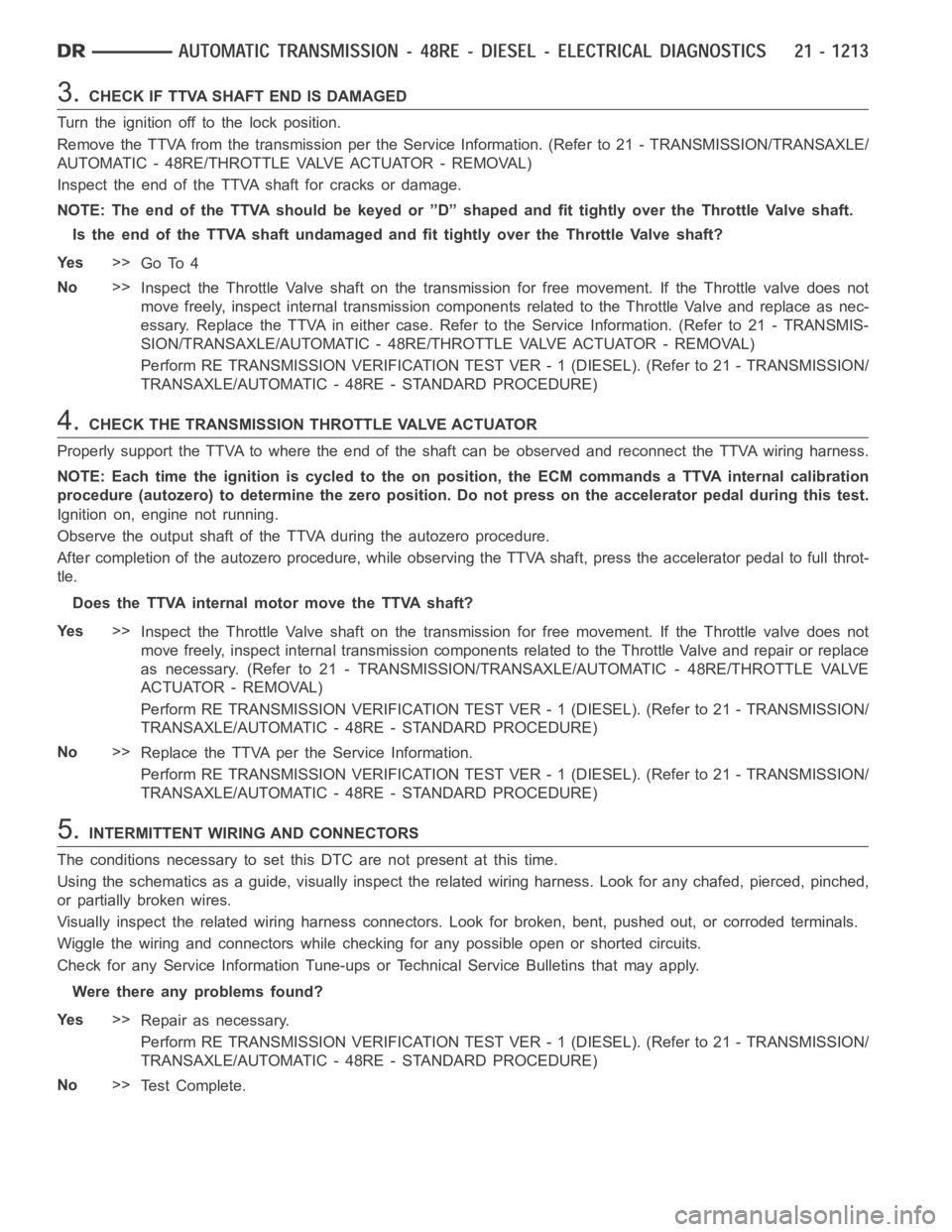
3.CHECK IF TTVA SHAFT END IS DAMAGED
Turn the ignition off to the lock position.
Remove the TTVA from the transmission per the Service Information. (Referto 21 - TRANSMISSION/TRANSAXLE/
AUTOMATIC - 48RE/THROTTLE VALVE ACTUATOR - REMOVAL)
Inspect the end of the TTVA shaft for cracks or damage.
NOTE: The end of the TTVA should be keyed or ”D” shaped and fit tightly over the Throttle Valve shaft.
Is the end of the TTVA shaft undamaged and fit tightly over the Throttle Valveshaft?
Ye s>>
Go To 4
No>>
Inspect the Throttle Valve shaft on the transmission for free movement. Ifthe Throttle valve does not
move freely, inspect internal transmission components related to the Throttle Valve and replace as nec-
essary. Replace the TTVA in either case. Refer to the Service Information.(Refer to 21 - TRANSMIS-
SION/TRANSAXLE/AUTOMATIC - 48RE/THROTTLE VALVE ACTUATOR - REMOVAL)
Perform RE TRANSMISSION VERIFICATION TEST VER - 1 (DIESEL). (Refer to 21 - TRANSMISSION/
TRANSAXLE/AUTOMATIC - 48RE - STANDARD PROCEDURE)
4.CHECK THE TRANSMISSION THROTTLE VALVE ACTUATOR
Properly support the TTVA to where the end of the shaft can be observed and reconnect the TTVA wiring harness.
NOTE: Each time the ignition is cycled to the on position, the ECM commands aTTVA internal calibration
procedure (autozero) to determine the zero position. Do not press on the accelerator pedal during this test.
Ignition on, engine not running.
Observe the output shaft of the TTVA during the autozero procedure.
After completion of the autozero procedure, while observing the TTVA shaft, press the accelerator pedal to full throt-
tle.
Does the TTVA internal motor move the TTVA shaft?
Ye s>>
Inspect the Throttle Valve shaft on the transmission for free movement. Ifthe Throttle valve does not
move freely, inspect internal transmission components related to the Throttle Valve and repair or replace
as necessary. (Refer to 21 - TRANSMISSION/TRANSAXLE/AUTOMATIC - 48RE/THROTTLE VALVE
ACTUATOR - REMOVAL)
Perform RE TRANSMISSION VERIFICATION TEST VER - 1 (DIESEL). (Refer to 21 - TRANSMISSION/
TRANSAXLE/AUTOMATIC - 48RE - STANDARD PROCEDURE)
No>>
Replace the TTVA per the Service Information.
Perform RE TRANSMISSION VERIFICATION TEST VER - 1 (DIESEL). (Refer to 21 - TRANSMISSION/
TRANSAXLE/AUTOMATIC - 48RE - STANDARD PROCEDURE)
5.INTERMITTENT WIRING AND CONNECTORS
The conditions necessary to set this DTC are not present at this time.
Using the schematics as a guide, visually inspect the related wiring harness. Look for any chafed, pierced, pinched,
or partially broken wires.
Visually inspect the related wiring harness connectors. Look for broken,bent, pushed out, or corroded terminals.
Wiggle the wiring and connectors while checking for any possible open or shorted circuits.
Check for any Service Information Tune-ups or Technical Service Bulletins that may apply.
Were there any problems found?
Ye s>>
Repair as necessary.
Perform RE TRANSMISSION VERIFICATION TEST VER - 1 (DIESEL). (Refer to 21 - TRANSMISSION/
TRANSAXLE/AUTOMATIC - 48RE - STANDARD PROCEDURE)
No>>
Te s t C o m p l e t e .
Page 3737 of 5267

2.CHECK THE TTVA POSITIONS WITH THE AUTO ZERO FEATURE
NOTE: Each time the ignition is cycled to the on position, the ECM commands aTTVA internal calibration
procedure (autozero) to determine the zero position.
With the scan tool, monitor the TTVA position during the autozero test.
Ignition on, engine not running.
After the autozero test is completed, record the position percentage value.
Press and hold the accelerator pedal to full throttle after completion of the autozero test and record.
Subtract the TTVA full throttle value from the value recorded after the autozero test.
Is the difference between the two values greater than or equal to 48 degrees?
Ye s>>
Go To 16
No>>
Go To 3
3.CHECK TTVA FOR SIGNS OF DAMAGE
Turn the ignition off to the lock position.
Visually inspect the TTVA shaft for any signs of external damage or improperly mounted.
NOTE: It is not necessary to remove the TTVA to perform this procedure.
Is the TTVA damaged or improperly mounted?
Ye s>>
Repair as necessary.
Perform RE TRANSMISSION VERIFICATION TEST VER - 1 (DIESEL). (Refer to 21 - TRANSMISSION/
TRANSAXLE/AUTOMATIC - 48RE - STANDARD PROCEDURE)
No>>
Go To 4
4.CHECK THE TTVA POSITIONS WITH THE TTVA REMOVED
Turn the ignition off to the lock position.
Remove the TTVA from the transmission per the Service Information. (Referto 21 - TRANSMISSION/TRANSAXLE/
AUTOMATIC - 48RE/THROTTLE VALVE ACTUATOR - REMOVAL)
NOTE: Check connectors - Clean/repair as necessary.
NOTE: Each time the ignition is cycled to the on position, the ECM commands aTTVA internal calibration
procedure (autozero) to determine the zero position.
Properly support the TTVA and reconnect the TTVA wiring harness.
With the scan tool, monitor the TTVA position during the autozero test.
Ignition on, engine not running.
After the autozero test is completed, record the position percentage value.
After recording the position percentage value, press and hold the accelerator pedal to full throttle and note position
percentage value.
Subtract the TTVA full throttle value from the value recorded after the autozero test.
Is the difference between the two values greater than or equal to 48 degrees?
Ye s>>
Repair internal transmission as necessary. Refer to the Service Information for proper repair procedures
for components related to the Transmission Throttle Valve.
Perform RE TRANSMISSION VERIFICATION TEST VER - 1 (DIESEL). (Refer to 21 - TRANSMISSION/
TRANSAXLE/AUTOMATIC - 48RE - STANDARD PROCEDURE)
No>>
Go To 5
Page 3738 of 5267
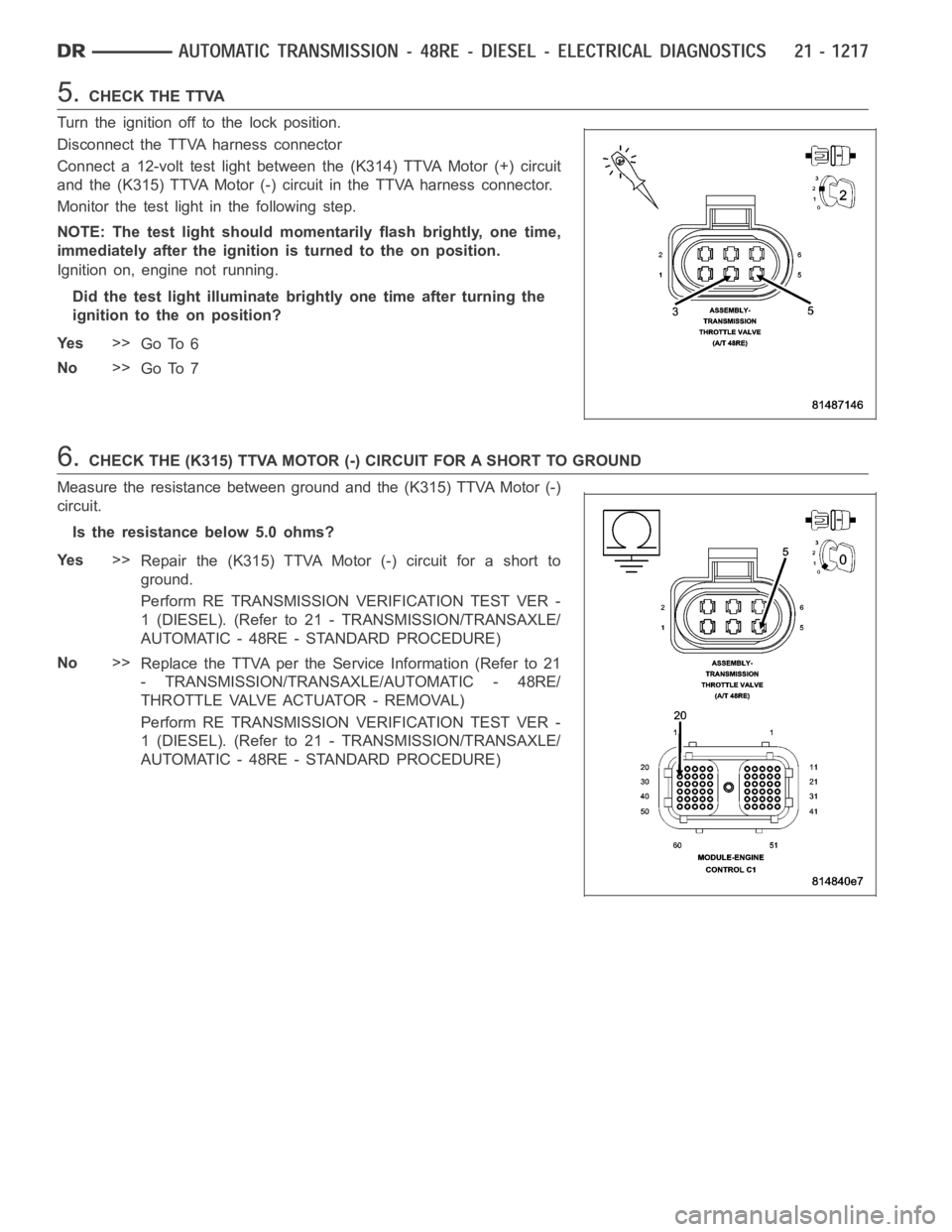
5.CHECK THE TTVA
Turn the ignition off to the lock position.
Disconnect the TTVA harness connector
Connect a 12-volt test light between the (K314) TTVA Motor (+) circuit
and the (K315) TTVA Motor (-) circuit in the TTVA harness connector.
Monitor the test light in the following step.
NOTE: The test light should momentarily flash brightly, one time,
immediately after the ignition is turned to the on position.
Ignition on, engine not running.
Did the test light illuminate brightly one time after turning the
ignition to the on position?
Ye s>>
Go To 6
No>>
Go To 7
6.CHECK THE (K315) TTVA MOTOR (-) CIRCUIT FOR A SHORT TO GROUND
Measure the resistance between ground and the (K315) TTVA Motor (-)
circuit.
Is the resistance below 5.0 ohms?
Ye s>>
Repair the (K315) TTVA Motor (-) circuit for a short to
ground.
Perform RE TRANSMISSION VERIFICATION TEST VER -
1 (DIESEL). (Refer to 21 - TRANSMISSION/TRANSAXLE/
AUTOMATIC - 48RE - STANDARD PROCEDURE)
No>>
Replace the TTVA per the Service Information (Refer to 21
- TRANSMISSION/TRANSAXLE/AUTOMATIC - 48RE/
THROTTLE VALVE ACTUATOR - REMOVAL)
Perform RE TRANSMISSION VERIFICATION TEST VER -
1 (DIESEL). (Refer to 21 - TRANSMISSION/TRANSAXLE/
AUTOMATIC - 48RE - STANDARD PROCEDURE)
Page 3743 of 5267
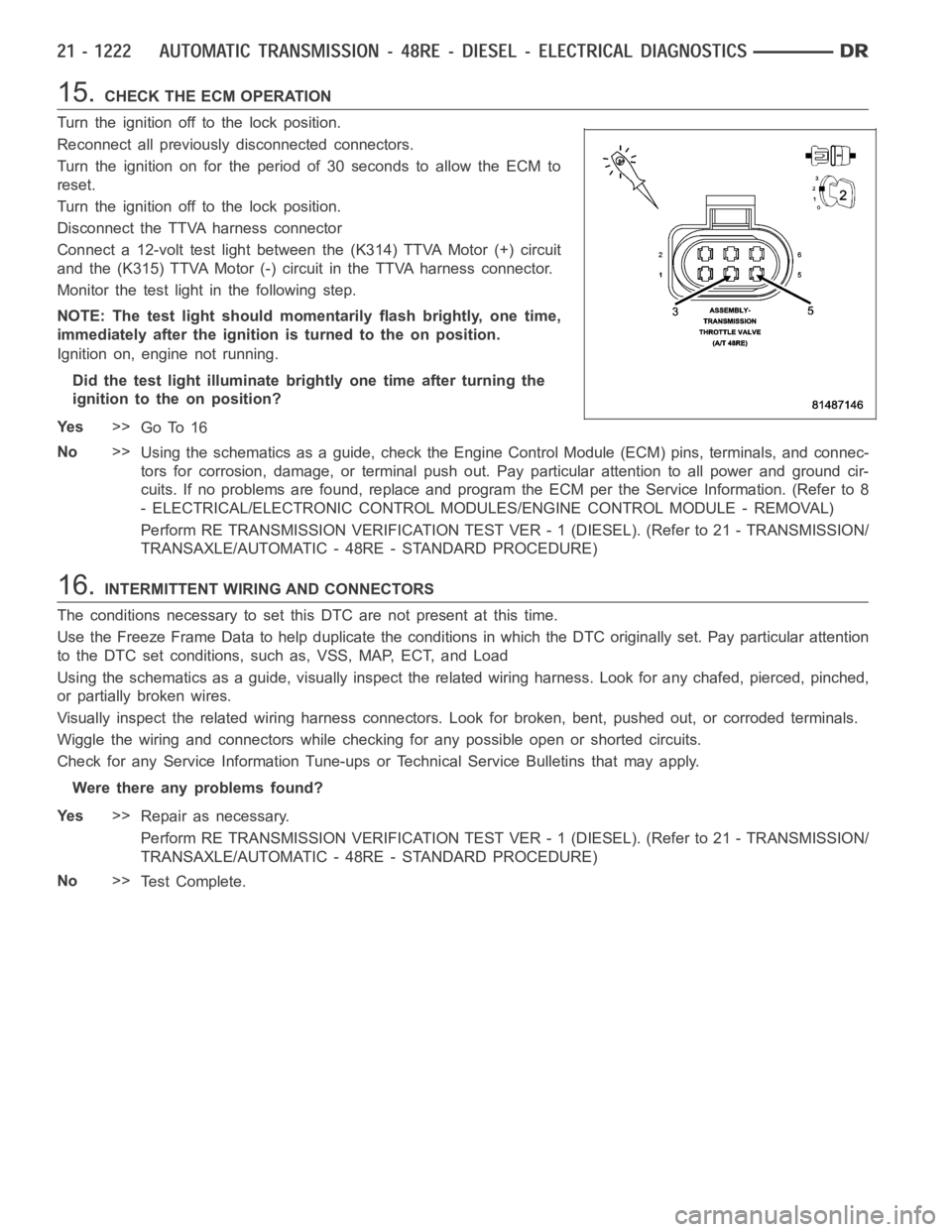
15.CHECK THE ECM OPERATION
Turn the ignition off to the lock position.
Reconnect all previously disconnected connectors.
Turntheignitiononfortheperiodof30secondstoallowtheECMto
reset.
Turn the ignition off to the lock position.
Disconnect the TTVA harness connector
Connect a 12-volt test light between the (K314) TTVA Motor (+) circuit
and the (K315) TTVA Motor (-) circuit in the TTVA harness connector.
Monitor the test light in the following step.
NOTE: The test light should momentarily flash brightly, one time,
immediately after the ignition is turned to the on position.
Ignition on, engine not running.
Did the test light illuminate brightly one time after turning the
ignition to the on position?
Ye s>>
Go To 16
No>>
Using the schematics as a guide, check the Engine Control Module (ECM) pins, terminals, and connec-
tors for corrosion, damage, or terminal push out. Pay particular attentiontoallpowerandgroundcir-
cuits. If no problems are found, replace and program the ECM per the ServiceInformation. (Refer to 8
- ELECTRICAL/ELECTRONIC CONTROL MODULES/ENGINE CONTROL MODULE - REMOVAL)
Perform RE TRANSMISSION VERIFICATION TEST VER - 1 (DIESEL). (Refer to 21 - TRANSMISSION/
TRANSAXLE/AUTOMATIC - 48RE - STANDARD PROCEDURE)
16.INTERMITTENT WIRING AND CONNECTORS
The conditions necessary to set this DTC are not present at this time.
Use the Freeze Frame Data to help duplicate the conditions in which the DTC originally set. Pay particular attention
to the DTC set conditions, such as, VSS, MAP, ECT, and Load
Using the schematics as a guide, visually inspect the related wiring harness. Look for any chafed, pierced, pinched,
or partially broken wires.
Visually inspect the related wiring harness connectors. Look for broken,bent, pushed out, or corroded terminals.
Wiggle the wiring and connectors while checking for any possible open or shorted circuits.
Check for any Service Information Tune-ups or Technical Service Bulletins that may apply.
Were there any problems found?
Ye s>>
Repair as necessary.
Perform RE TRANSMISSION VERIFICATION TEST VER - 1 (DIESEL). (Refer to 21 - TRANSMISSION/
TRANSAXLE/AUTOMATIC - 48RE - STANDARD PROCEDURE)
No>>
Te s t C o m p l e t e .